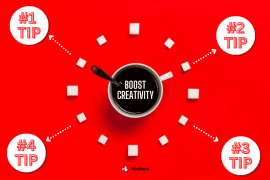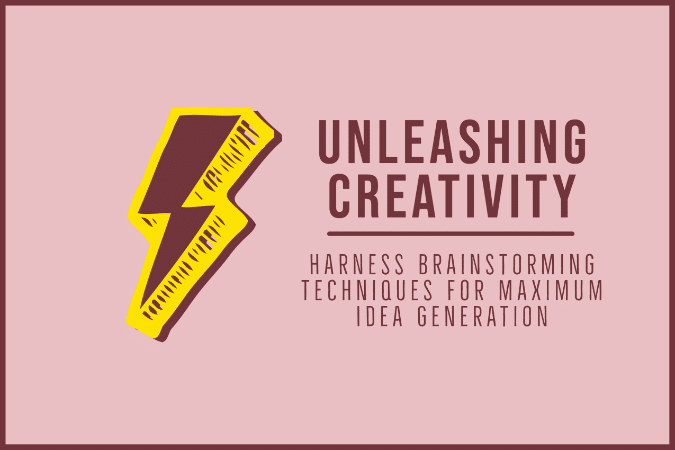
Imagine a bustling room. The air’s thick with electric anticipation. Around a table, diverse minds are gathering, primed to ignite the fuse of creativity. This is where ideas are about to sprout, where a seed of thought can blossom into innovative solutions.
This vibrant scene encapsulates the power of brainstorming, an all-inclusive process where the extraordinary emerges.
Brainstorming techniques are the unsung heroes behind this process. They act as the hidden catalysts sparking the explosion of new ideas. They’re creative exercises, unshackling the mind to explore fresh, uncharted territories. But they don’t stop there.
These techniques not only inspire the generation of new ideas. They also help organize your thoughts, transforming the chaos of the creative process into a structured brainstorming diagram.
This is the realm where creative problem-solving meets effective brainstorming techniques. It’s a place where team members unite in a brainstorming session, sharing their unique insights. And a vibrant group brainstorm is born. As diverse ideas ricochet around the room, an intricate network of thoughts forms, drawing lines between connections you never thought possible.
Whether you’re looking to generate new ideas quickly, delve into creative brainstorming techniques, or just get your creative juices flowing, brainstorming holds the key.
What are the 2 methods of brainstorming?
Brainstorming, at its core, can be seen as a dynamic duality. It comes alive in two principal forms, each with its distinct characteristics and strengths. Individual brainstorming and group brainstorming.
1. Coming up with creative ideas alone

Individual brainstorming is akin to a solitary quest into the labyrinth of your own mind. It’s a unique expedition into the wilderness of thoughts, a personal journey into the realm of ideas.
Here, one mind works independently, generating ideas at its own rhythm and pace, free from external distractions or interruptions. It’s an opportunity to let your creative juices flow without any fear of judgment or criticism, even if you come up with silly ideas. It’s a laboratory designed for the generation of ideas that might otherwise seem unconventional or even silly.
It’s an effective brainstorming technique, especially when you’re on the hunt for new ideas or creative answers to complex problems.
And there’s nothing quite like it. At least, not until you get a few other people together.
2. Group brainstorming techniques

Group brainstorming is a collective effort, more akin to a team sport where camaraderie and collaboration reign supreme over the entire group.
Here, the meeting of diverse perspectives creates a fertile ground for quality ideas. It’s the cradle of innovation where a simple idea from one team member can ignite a spark in another. It’s the place where one idea can lead to a chain reaction of thoughts, insights, and more.
It’s an environment where the best ideas often come from bouncing thoughts off each other, benefiting from the different perspectives and experiences of the team members.
However, group brainstorming is not without its challenges.
It can sometimes be stifled by dominant personalities or inhibited by the fear of judgment. This is where round robin brainstorming comes into play, ensuring each team member gets an equal opportunity to contribute ideas. Techniques like brainstorming writing, reverse brainstorming, or even employing a robust brainstorming tool can help navigate these challenges.
A brainstorming exercise like these levels the playing field, fostering an environment of mutual respect and open dialogue where every idea is valued. They ensure that every voice is heard and every thought considered. This is what will make every brainstorming session a platform for effective idea generation and creative problem solving.
Which ways are better to develop ideas?
There’s no need to pit individual vs group brainstorming any more than we should put mind mapping vs brainstorming. Every tool we have at our disposal should be used. Great ideas aren’t born in only one way.
The choice between individual and group brainstorming is not a matter of superiority but suitability. It’s about understanding the nuances of the brainstorming process. Then, it’s about selecting the right technique that aligns with your goal and creating an environment where ideas can flow freely.
No matter what you’re trying to achieve, brainstorming can help. Generate ideas quickly. Inspire a team brainstorm that leads to more getting done. Cultivate creative ideas and decide how to execute them. It’s all possible with the help of individual and group brainstorming techniques.
Why brainstorming techniques are essential
Brainstorming is not merely a mental exercise or a method to pass time during a meeting. It’s an essential process. It’s a strategic tool that harnesses collective intelligence and converts it into problem-solving powerhouses and creative think-tanks. In an era defined by innovation and fresh ideas, brainstorming techniques have emerged as vital elements for success in any field.
So, what’s the best brainstorming technique to come up with as many ideas as possible?
Here are a few great methods for developing your own ideas.
Group discussions as a brainstorming technique
Consider group discussions. They may begin as casual conversations or formal meetings. But with the right brainstorming techniques, they can morph into dynamic idea generation sessions.
Every team member becomes an active participant, contributing unique insights and sharing ideas. This helps to develop an idea further or provide a different perspective that leads to a solution.
Other brainstorming techniques
Several brainstorming techniques have proven to be particularly effective in stimulating creative thinking. Here are a few of the most popular:
- Reverse brainstorming encourages you to flip the problem on its head and think of ways to achieve the opposite effect. This helps highlight potential pitfalls and new solutions.
- Round robin brainstorming ensures group members have an equal chance to voice their ideas, creating a judgment-free zone, and encouraging more participation.
- Brain writing offers a silent alternative where ideas are written down and passed around. This ensures even the introverted members can contribute without feeling pressured to speak up.
The value of a brainstorming technique
Each of these techniques plays a pivotal role in keeping the brainstorming process on track and ensuring fresh ideas are regularly brought to the table. Their application results in a diverse brainstorming diagram, a visual representation of a wide array of potential solutions. Each idea that arises from the brainstorming session, whether it stems from individual brainstorming or a group brainstorming session, is unique and valuable.
Moreover, these techniques can serve as an effective brainstorming tool in the digital age. Online brainstorming transcends geographical boundaries. This makes them invaluable in today’s increasingly remote and digital workspaces.
But it’s not just about idea generation. Brainstorming techniques are equally crucial when it’s time to organize ideas, evaluate them, and identify the best ones. They help ensure that the brainstorming process is efficient and productive, leading to actionable results.
In short, the importance of brainstorming techniques cannot be overstated. They help generate ideas quickly, encourage creative problem solving, and ensure every team member can contribute their ideas. By turning group discussions into idea generation powerhouses, brainstorming techniques hold the key to unlocking the full potential of collective intelligence.
Tips for making the most of your next brainstorming session
Getting ready to dive into your next brainstorming session? Whether it’s an individual brainstorming quest or a lively group brainstorming meeting, it’s essential to make the most of it. Here are some tried-and-true tips to ensure your session is a hotbed of idea generation and creative problem-solving.
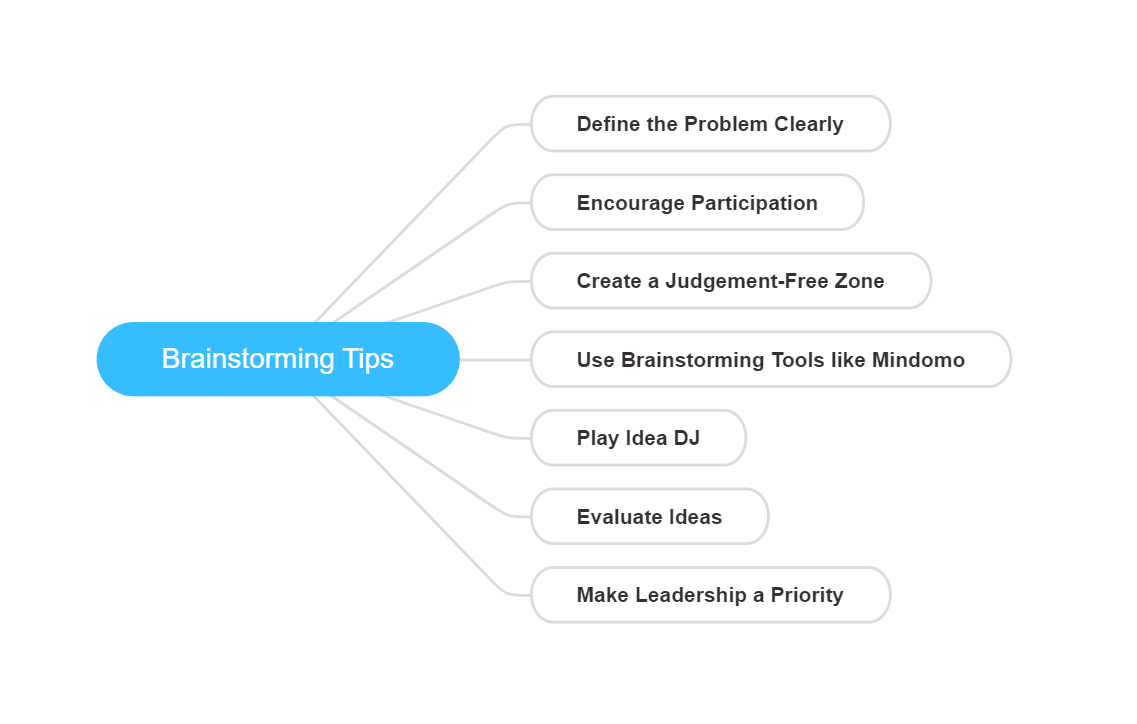
- Define the Problem Clearly: Begin your brainstorming session with a clear definition of the problem at hand. Understanding the problem is the first step towards finding a solution. The more precise and comprehensive your problem statement, the more focused your brainstorming process will be. It’s also a great way to initiate the brainstorming technique that works best for your needs.
- Encourage Participation: Whether it’s a team leader or a new team member, every participant brings a unique perspective to the table. Encourage everyone to share ideas, contributing to the group discussion. Techniques like round robin brainstorming can be instrumental in fostering a sense of equality and inclusivity.
- Create a Judgment-Free Environment: The best ideas often come from the wildest, silliest thoughts. Foster an environment where every idea is welcomed and considered. This open-mindedness can boost creativity, get the creative juices flowing, and ensure the brainstorming diagram fills up with diverse ideas.
- Use Diagram Software or Mind Mapping Tools: As ideas start pouring in, use a robust mind mapping tool like Mindomo to help organize your thoughts. Mind mapping software can help you with rapid ideation and visualizing connections. A mind map can help you make sense of the chaos and streamline the process of developing ideas. It’s an easy way to develop creative solutions. So don’t hesitate to explore the many mind mapping benefits out there.
You can use one of the following brainstorming diagram templates to find new ideas:
Star mind map:
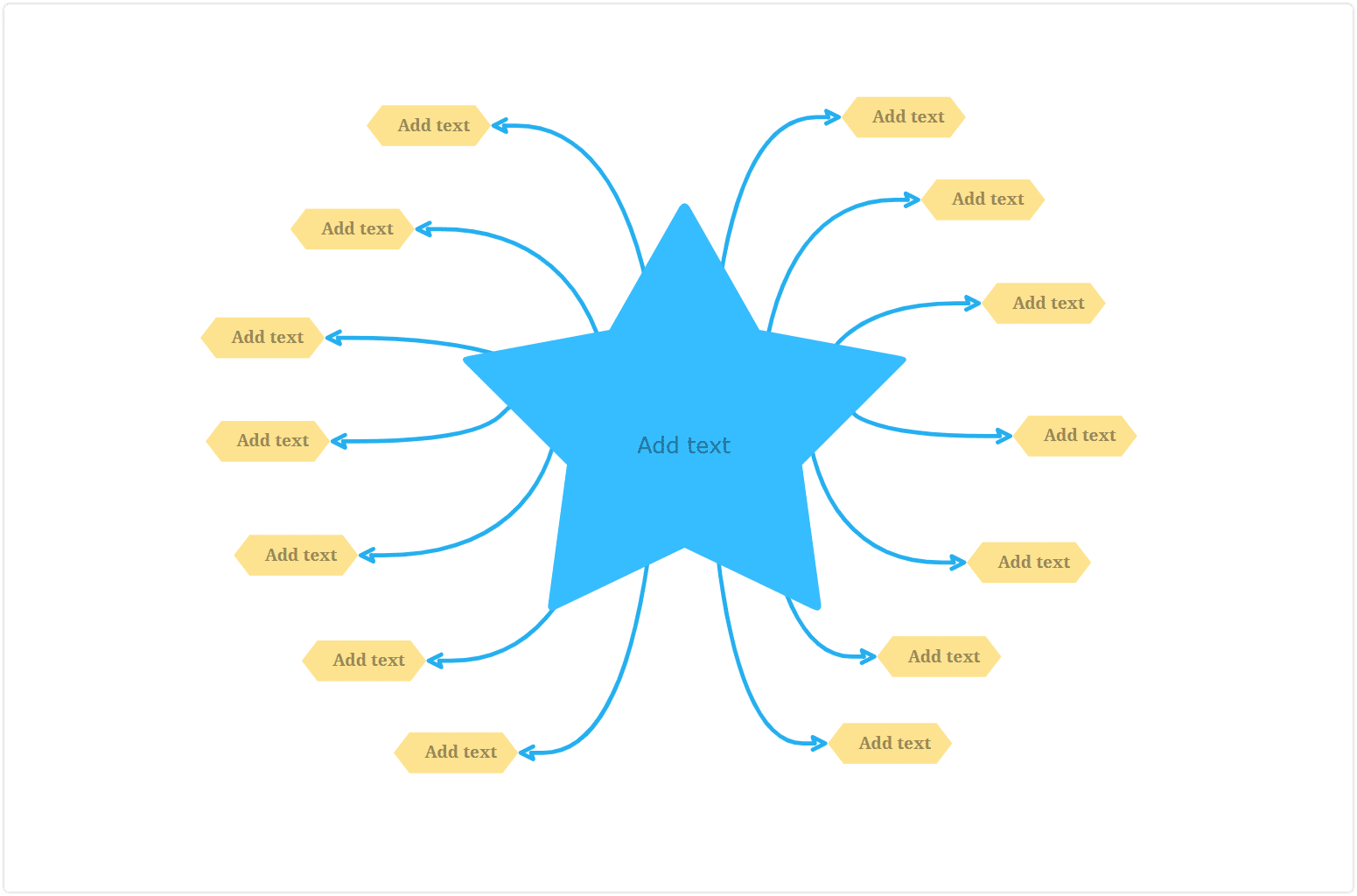
Grapes brainstorming:
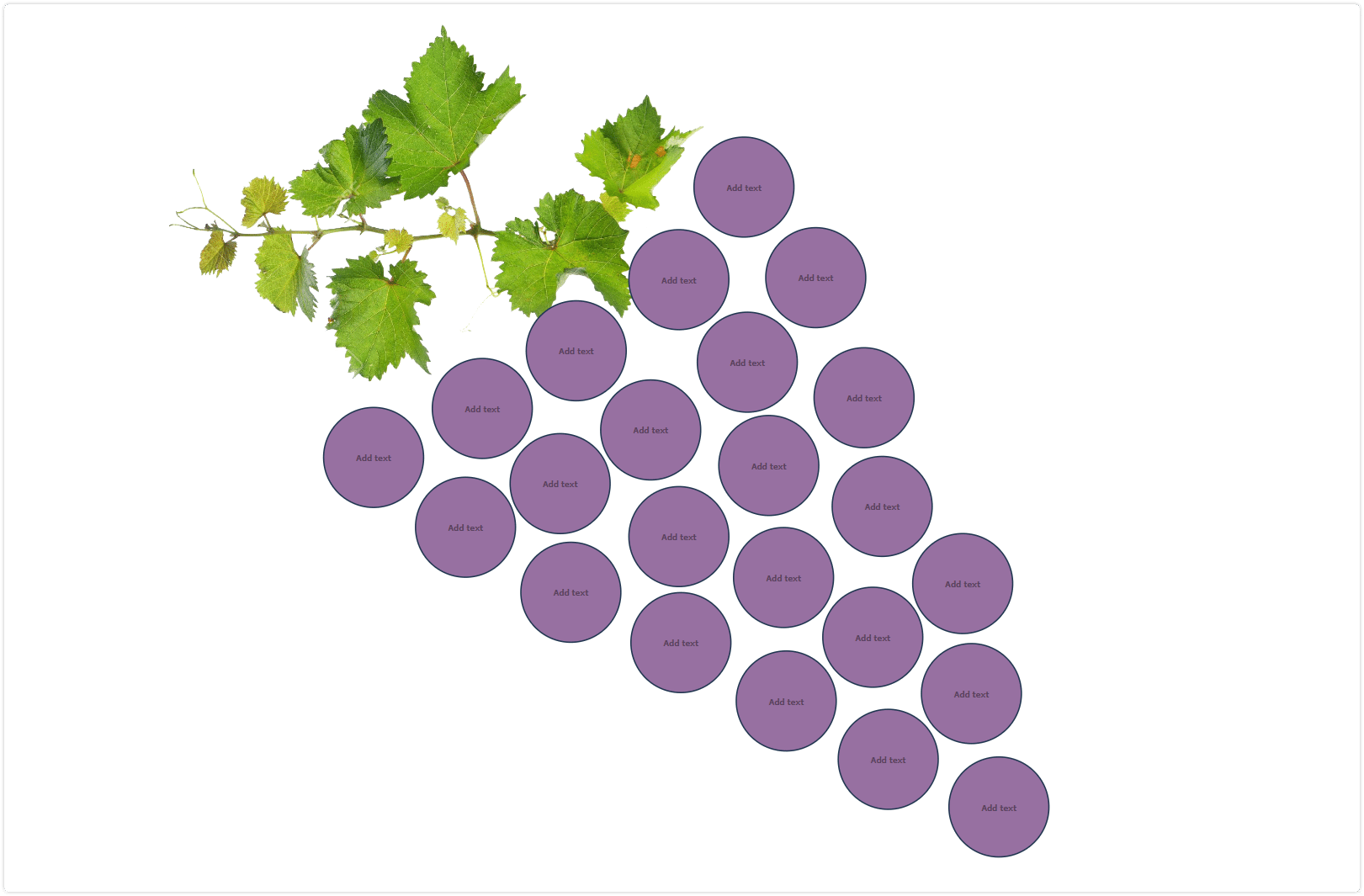
What’s in your head:
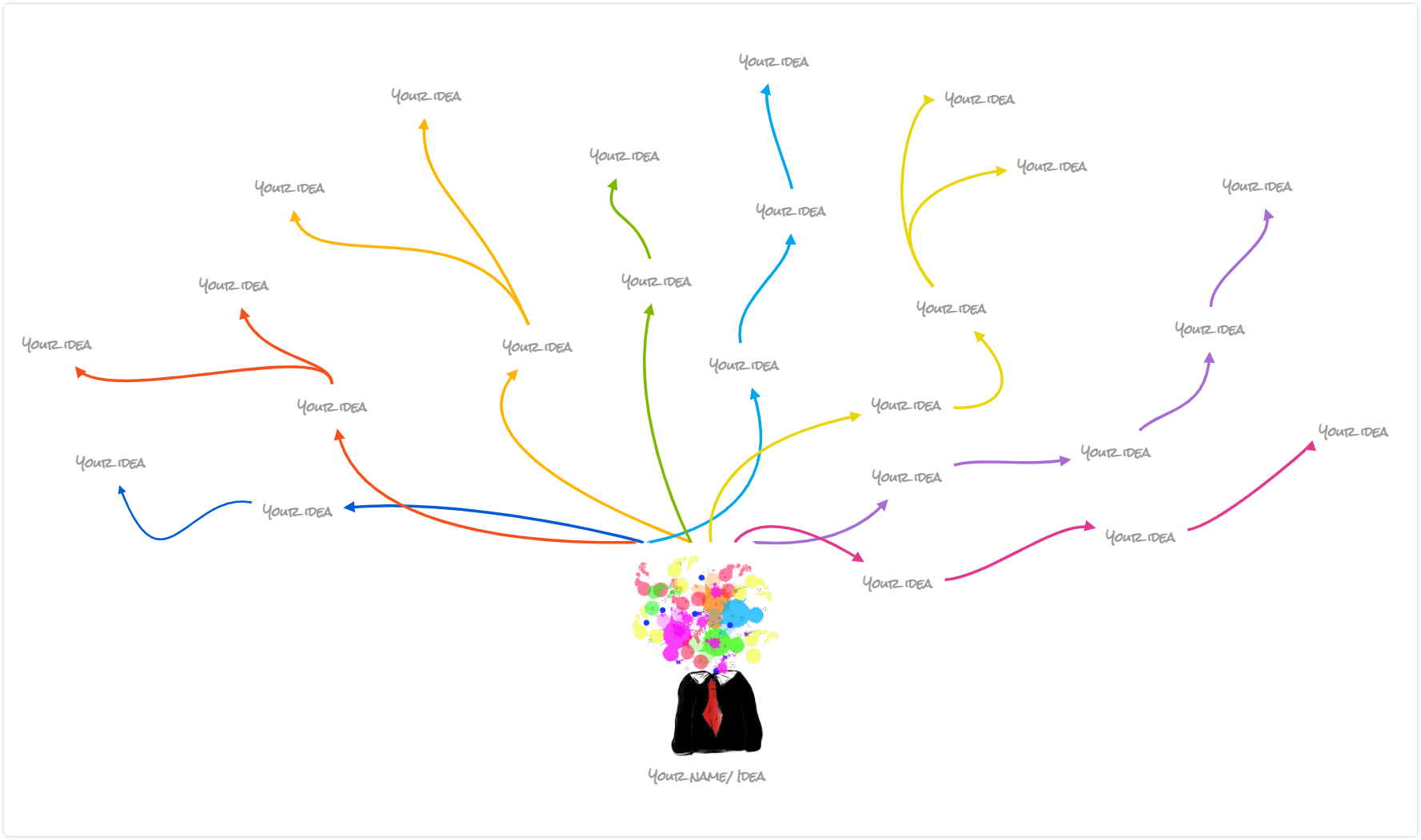
Cyan Wheel:
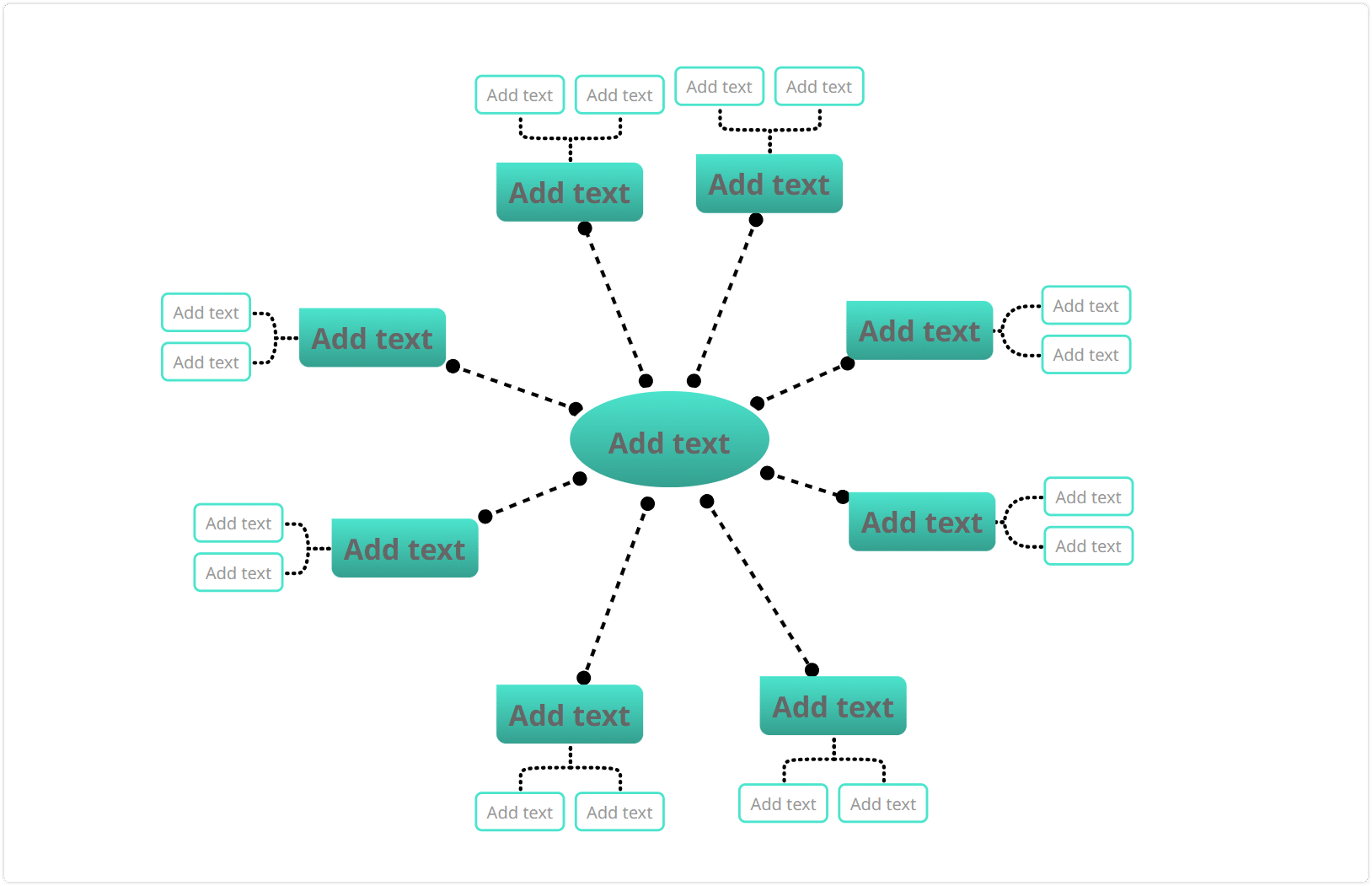
5. Play ‘Idea DJ’: As the team members contribute ideas, some will spark other ideas, leading to a chain reaction of thoughts. Keep track of these connections and use them to expand the brainstorming process. This technique encourages the evolution of initial ideas into innovative solutions.
6. Evaluate as Many Ideas as Possible: Once you’ve generated as many ideas as you need, it’s time to evaluate them. Tools and techniques can help sift through the heap of ideas, helping you pick out the diamonds. Remember, not all great ideas look brilliant at first glance.
7. The Crucial Role of the Team Leader: A team leader’s role in a brainstorming session is pivotal. They should guide the team through the process, balance the contribution of ideas, and ensure that every voice is heard. Their role includes fostering a supportive environment, managing the brainstorming process, and steering the team towards effective brainstorming.
Armed with these tips, you’re ready to maximize the potential of your next brainstorming session. Remember, the goal isn’t just to generate ideas but to ignite a creative brainstorm that leads to effective solutions. Keep the creative energy alive, encourage the free flow of ideas, and watch as your brainstorming sessions transform into platforms for innovation.
Conclusion
Unleashing creativity and generating fresh, innovative ideas aren’t as daunting as it seems. With the right brainstorming techniques and tools, you can transform any group discussion into a dynamic idea generation session. It’s time to harness the power of brainstorming and let your ideas shine. Get ready to supercharge your creativity in your next brainstorming session!
Keep it smart, simple, and creative!
The Mindomo Team



